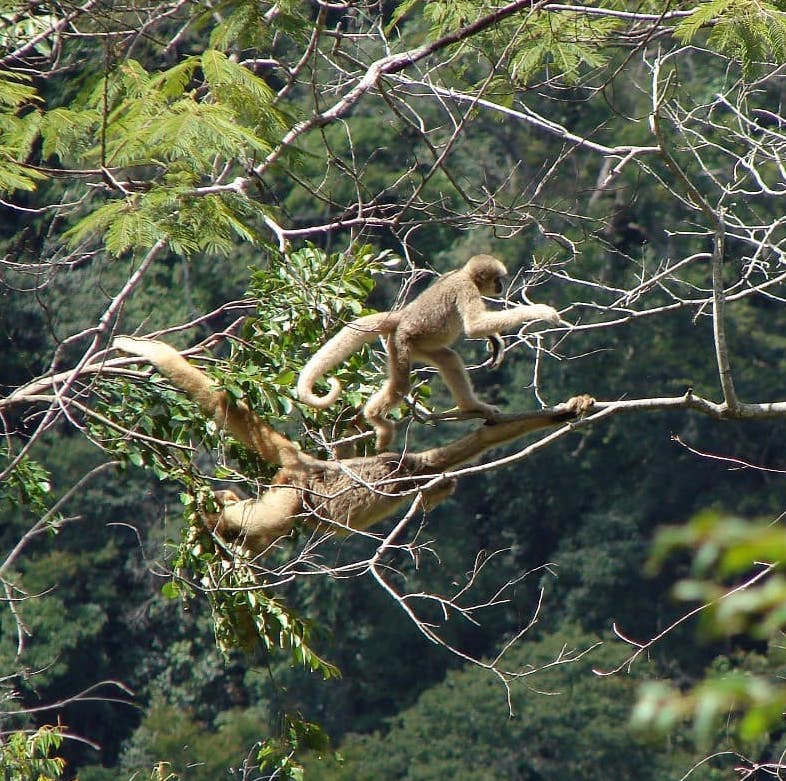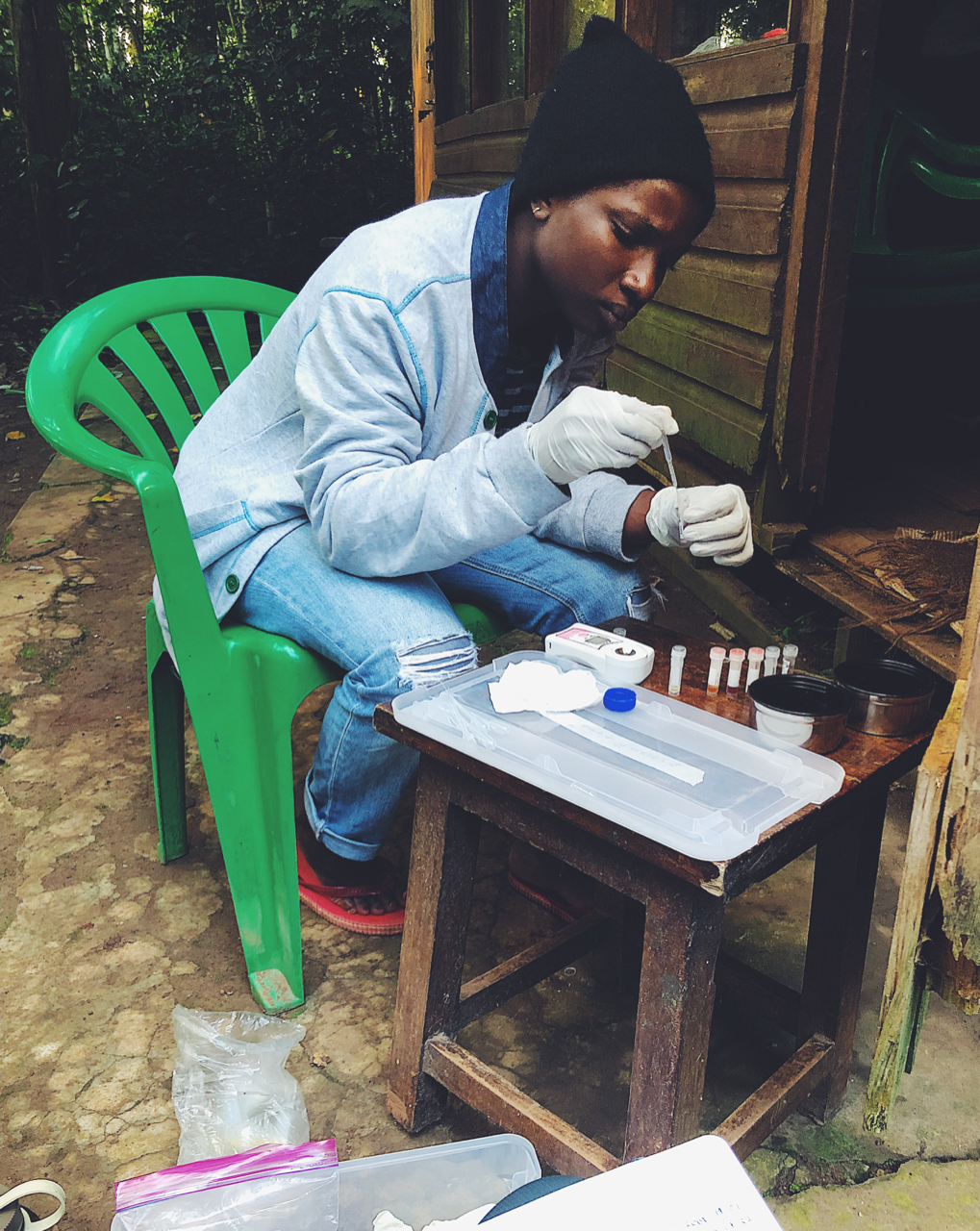- Wildlife researchers can obtain information from fecal samples on animals’ reproductive status, parentage, genetic relationships, and presence of parasites or viruses, such as Zika.
- Scientists studying wild primates in South America in the 1990s developed techniques to help them understand how hormones, steroids and other compounds related to the animals’ reproductive behaviors.
- More recently, scientists are testing whether fecal sampling can help identify parasites carrying diseases such as Zika virus or detect changes in the microbiome that could improve its contributions to host energy balances and nutrition and help them survive nutritionally stressful periods.
- Fecal sampling is a noninvasive method of capturing this information but getting and keeping the equipment and materials needed to process the samples is challenging.
Did you ever think about the information we can gain from a simple sample of feces? Wildlife researchers have, and the information they obtain from poop samples can tell them about animals’ reproductive status, parentage, genetic relationships, and presence of parasites or viruses, such as Zika.
For decades, wildlife researchers have poked through and analyzed the feces of their subjects to see what the animals were eating. More recently, fecal analysis has provided researchers with a noninvasive way to gather far more information. Researchers studying wild primates, for example, have been analyzing fecal samples for several decades thanks to advances in techniques to isolate hormones, DNA and microorganisms from fecal matter.
Early uses of primate fecal samples
One of the pioneers in using feces to monitor a primate population is Karen Strier, a professor at the University of Wisconsin-Madison. She studies muriqui monkeys, at one time also known as woolly spider monkeys, a large primate native to Brazil that lives in the forest canopy.
Early in her career in the 1990s, Strier was interested in studying the muriqui’s reproductive biology to better understand when females in her study groups were ovulating and when they became pregnant. That kind of information is potentially valuable for assessing the population and for managing its conservation.

Because of the muriquis’ endangered status and Strier’s commitment to doing research in the least invasive way possible, she began exploring noninvasive sampling methods. She had recently met Toni Ziegler, now at the Wisconsin National Primate Research Center (located at the University of Wisconsin-Madison), who at the time was a fellow early-career researcher.
They came across research that found that steroid hormones could be extracted from fecal samples and linked to the menstrual cycle and pregnancy in captive and wild primates. The duo began developing ways to do this with the wild muriqui populations Strier was studying.
Taking fecal and urine samples from wildlife is a noninvasive way to monitor their physical status. For researchers who study endangered species, it is even more important to explore noninvasive techniques so as to not stress or disturb their study species. Although Strier was able to observe the female muriquis of her study group, she could not observe all the time and knew she might miss some key behavioral events.“You can’t always map behavior to reproduction. If you want to understand what’s going on physiologically, you need some kind of physiological mechanism,” Strier told Mongabay. That’s where the hormones come in. Strier and Ziegler got to work developing their own methods for sampling feces and extracting hormones. Besides being patient and waiting for the monkeys to defecate, finding, collecting and processing fecal samples can be complicated.
In the early days, they would take some of the fecal samples and put them in vials with ethanol to ship back to labs in the United States. Logistically, shipping the samples presented difficulties because there were limitations on the quantity of ethanol allowed within a package.
Later on, the scientists modified the use of cartridges normally used to extract the hormones in the lab so that they could do the extractions while in the field. This meant they could ship the cartridges containing just the hormones, rather than the fecal material in ethanol. Strier and Ziegler published their findings about the reproductive cycle of muriquis in 1997, reporting the females’ average cycle lengths and gestation lengths among other bits of information.

Researchers also study primate reproductive behavior through DNA analysis. One of Strier’s collaborators, Anthony Di Fiore of the University of Texas at Austin, wanted to study the reproductive biology and behavior of woolly monkeys, including their mating systems and population structure. Scientists can habituate primates to human presence, which enables them to follow groups and assess the behavior of each individual monkey so long as it stays with the group.
“So one of the things that I couldn’t tell when I was watching [the] monkeys was which sex was the dispersing … and how far animals were moving when they left their social groups,” Di Fiore told Mongabay.
From their fecal samples collected in Ecuador, he was able to extract DNA and use it to assess the gender and relatedness among individuals within a group. Di Fiore and collaborators used this genetic information to determine that both female and male woolly monkeys were dispersing and joining other groups as adults, which was in line with field observations.
Di Fiore’s group is also investigating reproductive success and parentage. Based on the hormone data, they can tell when females are ovulating and match that up with behavior, such as which individuals they are meeting with and at what times, and the animals’ sexual behavior, said Di Fiore.
Using fecal and urine samples, he and his team are also investigating male cooperative behavior in woolly monkeys and spider monkeys that focuses on how hormones and other markers match up with patrolling and territorial defense.
Studying microorganisms in primates
Researchers are also asking questions about primate microbiomes. Katie Amato, an assistant professor at Illinois’s Northwestern University, became interested in this topic when she noticed research that suggested obesity was partly caused by microbes, and specifically microbes that might be producing energy that hosts could use more efficiently. She’s currently applying techniques to primates in Mexico.
“I thought it would be really interesting … to try to understand if there were changes in the microbiome that could improve its contributions to host energy balances and nutrition, and could actually help them survive nutritionally stressful periods,” Amato said.
“The challenge with microbiome samples is you have to basically get them frozen, or somehow preserved, almost immediately,” Amato said. “As soon as an animal poops, the environment that those microbes are in has now changed dramatically.” The change in environment can mean that certain microbial species will start to grow more rapidly than others, thus changing the relative abundances of the species that are present and giving the researchers a skewed view of the microbial ecosystem.
To prevent this from happening, Amato puts the fecal sample straight into ethanol, killing all of the microbes instantly, and later uses polymerase chain reaction (PCR) techniques to tell what species are present according to the relative amounts of DNA. However, if researchers want to be able to culture the microbial species on petri dishes later in the lab, the fecal samples need to be frozen within about four to six hours of collection and need to remain frozen all the way to the lab.
Other researchers are focusing on infectious diseases in primates. Krista Milich, an assistant professor at Washington University at St. Louis, is studying the arrival of Zika virus in primate populations in South America. She and collaborators have successfully isolated the virus from captive-bred primates infected with the virus, and their current ongoing study aims to identify which South American primate species may be harboring Zika in the wild.
Viruses are tricky to deal with, especially in feces, because researchers are looking for viral RNA, which are single-stranded and inherently less stable as a compound than double-stranded DNA.
“They’re much more sensitive,” Milich told Mongabay. If the samples aren’t handled and stored correctly, there is a high chance of not detecting the virus simply because it is fragile, and it was destroyed before you have a chance to detect it.
For the Zika studies, they must freeze the fecal samples in the field to preserve the virus if it’s there. That means they need access to either liquid nitrogen or freezers, often in remote locations like the Amazon forest, and that can be very expensive. Back in the lab, Milich and collaborators have to first extract the viral RNA, and then use a reverse transcriptase PCR method to detect whether Zika virus is there.

New research options
Up-and-coming researchers are benefiting from the pioneering of primatologists like Strier, Ziegler and Di Fiore. For example, Ronnie Steiniz of the University of California, Santa Barbara (UCSB), is using similar techniques to study red-tailed monkeys in Uganda. These small monkeys eat fruits and insects, but often share habitats with larger primates like chimpanzees and mangabeys.
Using fecal and urine samples, Steiniz hopes to find patterns in hormones and biomarkers like C-peptide, cortisol and triiodothyronine that relate to resource competition with other primate species in locations with varying levels of resources and habitat disturbance.

Parasite load may tell another story. Hannah Frogge, also of UCSB, hopes that by identifying the parasites in the feces of a slowly dwindling population of blue monkeys in Kibale National Park in Uganda, she’ll be able to determine whether the burden of parasites is affecting their survival.
“Whenever we’re looking at parasites, we’re also seeing if they’re symptomatic,” Frogge said. And that pairing of behavioral observations and the lab results is what makes feces sampling such an important and powerful approach to studying wild primate populations.
What fecal analysis makes possible
Because researchers record primate behavior nearly continuously, the biggest strength of using noninvasive approaches like feces and urine sampling is being able to pair them with concurrent behavioral observations and increasingly more advanced lab techniques. These noninvasive methods help researchers ask new questions while minimizing impact on wild populations.
“I think we’re starting to be able to address some of these bigger questions more effectively,” Amato said. And because many primatologists are already conducting long-term studies, they can coordinate data collection and analysis.
Di Fiore agreed, highlighting the interdisciplinarity of contemporary organismal biology and noting that it integrates behavioral observations in the field with a variety of lab techniques. He added, “You can learn a lot more about the actual history of the behavioral biology [and] the adaptation of these critters by taking that collaborative, interdisciplinary approach.”
Citations
- Di Fiore, A., Link, A., Schmitt, C. A., & Spehar, S. N. (2009). Dispersal patterns in sympatric woolly and spider monkeys: integrating molecular and observational data. Behaviour, 437-470.
- Strier, K. B., & Ziegler, T. E. (1997). Behavioral and endocrine characteristics of the reproductive cycle in wild muriqui monkeys, Brachyteles arachnoides. American Journal of Primatology, 42(4), 299-310.
